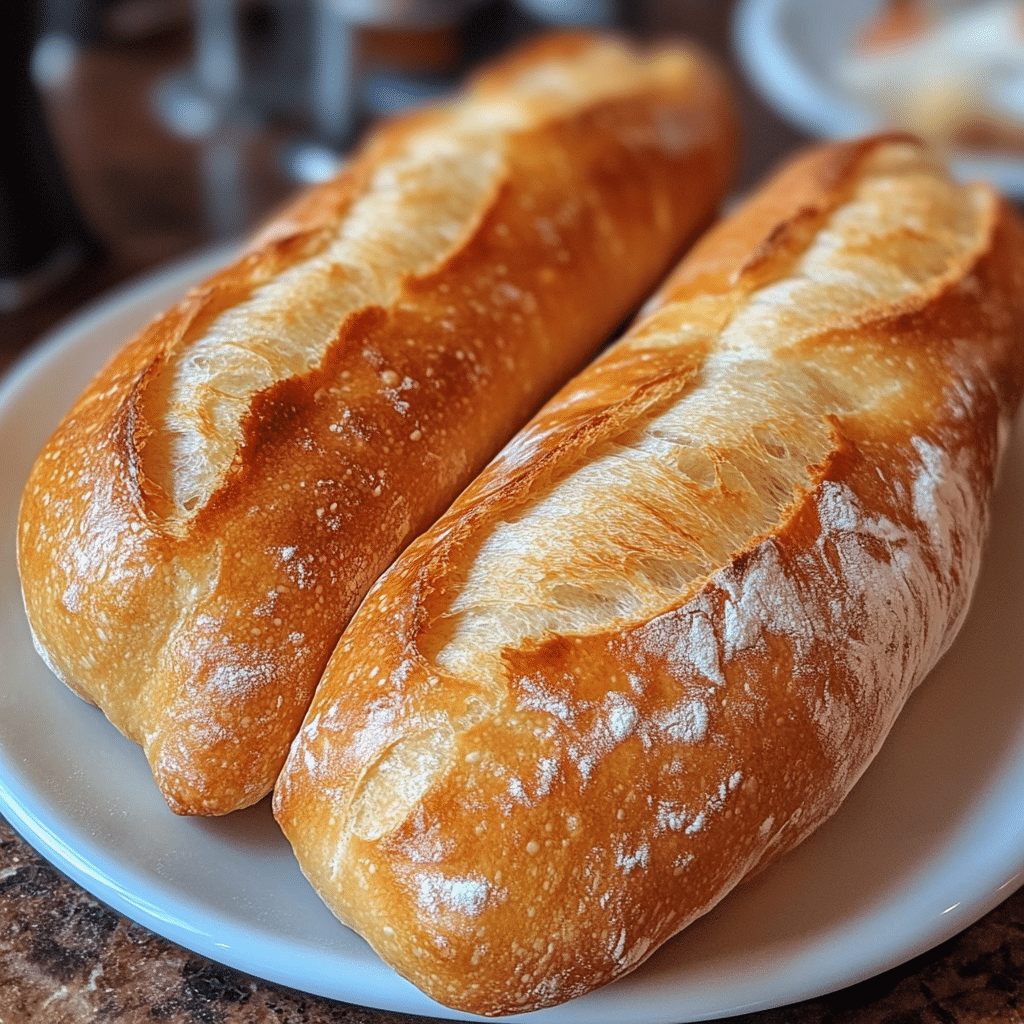The baguette is a symbol of French baking, and for good reason. With its long, golden, crisp exterior and soft, airy interior, this classic French bread is a delicious addition to any meal. Perfect for everything from breakfast to dinner, baguettes are versatile and can be used for sandwiches, served alongside soup, or enjoyed with butter and jam. Making a traditional baguette from scratch can seem daunting, but with a few simple ingredients and some patience, you’ll be able to create bakery-quality bread right at home.
This recipe will guide you through the steps to create a beautiful, fresh baguette. Whether you’re making it for a special dinner or just craving something fresh, this homemade baguette will fill your kitchen with the delightful aroma of freshly baked bread.
Why You’ll Love This Recipe
1. Crispy Golden Crust
The crispy, golden crust of a freshly baked baguette is one of its most irresistible features. It provides the perfect contrast to the soft, airy interior.
2. Customizable for Any Meal
A baguette is incredibly versatile and can be used in a variety of dishes, from sandwiches to serving alongside soups and stews. It’s the perfect bread for almost any occasion.
3. Fresh, Homemade Taste
There’s nothing quite like the taste of homemade bread. This recipe lets you enjoy the freshness and satisfaction of baking your own baguettes.
4. Simple Ingredients
This recipe uses basic ingredients that are easy to find, making it a great option for home bakers of all levels.
5. Perfect for Sharing
Baguettes are great for serving at family dinners or parties. Slice it up and serve with dips, cheeses, or charcuterie—everyone will enjoy it!
Ingredients
- All-purpose flour
- Water
- Yeast (active dry or instant)
- Salt
- Sugar (optional, for feeding the yeast)
- Olive oil (optional, for extra flavor and softness)
Variations
- Whole Wheat Baguette: Replace a portion of the all-purpose flour with whole wheat flour for a healthier, heartier baguette with more fiber.
- Herb-Infused Baguette: Add fresh herbs such as rosemary or thyme to the dough for a fragrant, flavorful twist.
- Garlic Baguette: Mix in roasted garlic or garlic powder into the dough for a savory, aromatic baguette perfect for serving with pasta or soup.
- Cheese Baguette: Add shredded cheese (such as Gruyère or cheddar) into the dough for a cheesy baguette with a delightful twist.
How to Make the Recipe
Step 1: Activate the Yeast
In a small bowl, combine the warm water (about 110°F or 43°C) with sugar (if using) and the yeast. Stir and let it sit for 5-10 minutes, or until it becomes frothy.
Step 2: Mix the Dough
In a large mixing bowl, combine the flour and salt. Create a well in the center and pour in the activated yeast mixture. Stir with a wooden spoon until the dough starts to come together. If it’s too sticky, you can add a little more flour.
Step 3: Knead the Dough
Turn the dough out onto a lightly floured surface and knead for 8-10 minutes until it’s smooth and elastic. You can also use a stand mixer with a dough hook attachment to knead the dough for about 6-8 minutes.
Step 4: First Rise
Place the dough in a lightly oiled bowl, cover it with a clean kitchen towel, and let it rise in a warm place for 1-1.5 hours, or until it doubles in size.
Step 5: Shape the Dough
Once the dough has risen, punch it down to release the air. Divide the dough into two equal pieces. Shape each piece into a long, thin loaf (about 14-16 inches in length). Place the shaped dough on a baking sheet lined with parchment paper or a baguette pan.
Step 6: Second Rise
Cover the loaves with a kitchen towel and let them rise for another 30-45 minutes, or until they have puffed up and are nearly double in size.
Step 7: Preheat the Oven
While the dough is rising, preheat your oven to 475°F (245°C). Place a shallow pan of water on the bottom rack to create steam, which helps form a crispy crust.
Step 8: Score the Baguettes
Before baking, make 3-4 diagonal slashes along the top of each baguette using a sharp knife or a razor blade. This will allow the bread to expand during baking.
Step 9: Bake
Place the loaves in the oven and bake for 20-25 minutes, or until the crust is golden brown and the loaves sound hollow when tapped on the bottom. You can check the internal temperature of the baguettes; it should read around 200°F (93°C).
Step 10: Cool
Remove the baguettes from the oven and transfer them to a wire rack to cool. Let them cool for at least 20 minutes before slicing.

Tips for Making the Recipe
- Use Warm Water: Make sure the water is warm, not hot, to activate the yeast. Water that’s too hot can kill the yeast, preventing the dough from rising.
- Steam is Key: Creating steam in the oven helps develop the crispy crust. You can place a baking pan with water on the lower rack or spritz the oven with water using a spray bottle right before baking.
- Don’t Overcrowd the Pan: If making more than one baguette, leave enough space between them on the baking sheet so they have room to expand and bake evenly.
- Allow Enough Rise Time: Don’t rush the rising process. Let the dough rise fully to get the light, airy texture that baguettes are known for.
- Use a Pizza Stone: If you have a pizza stone, bake the baguettes on it for an even crispier crust.
How to Serve
Baguettes are perfect for serving alongside a variety of dishes. They pair well with soups, salads, or charcuterie platters. Slice them for sandwiches, or simply enjoy with a smear of butter or your favorite spread. A warm baguette with a good cheese or some pate is a classic, simple French delight. You can also slice them and toast them for a crunchy appetizer or serve them with a dipping oil.
Make Ahead and Storage
Storing Leftovers
Store any leftover baguettes in a bread box or wrap them tightly in a cloth to maintain their freshness. For best results, consume within 2-3 days.
Freezing
To freeze a baguette, allow it to cool completely, then wrap it in plastic wrap and foil. You can freeze it for up to 3 months. When ready to use, let it thaw at room temperature, then refresh it by baking it at 375°F (190°C) for about 10 minutes for a crispy finish.
Reheating
Reheat slices of baguette in a toaster oven or regular oven at 350°F (175°C) for about 5-7 minutes until warm and crispy. You can also slice it and toast it for a crunchy texture.
FAQs
1. Can I use bread flour instead of all-purpose flour?
Yes, bread flour will give the baguette a slightly chewier texture, but all-purpose flour works just fine for this recipe.
2. What can I do if my dough isn’t rising?
If your dough isn’t rising, the yeast may be old or the environment may be too cold. Try placing the dough in a warmer spot or giving the yeast a little more time to activate.
3. Can I make baguette dough ahead of time?
Yes, you can prepare the dough, let it rise, and then refrigerate it overnight. When you’re ready to bake, let the dough come to room temperature before shaping and continuing with the recipe.
4. Can I add flavorings to the dough?
Yes, you can add herbs, garlic, or even grated cheese to the dough to create different flavors. Just mix them into the dough when you combine the dry ingredients.
5. Can I bake multiple baguettes at once?
Yes, you can bake more than one baguette, but make sure they have enough space on the baking sheet to expand without touching each other.
6. Do I need a baguette pan?
A baguette pan is helpful, but not necessary. You can bake the baguettes directly on a baking sheet lined with parchment paper.
7. How can I make my baguette crustier?
To achieve a crispier crust, make sure to create steam in the oven by adding a pan of water to the oven or spraying the dough with water before baking.
8. Why is my baguette too dense?
If your baguette is dense, it may have overproofed or been under-kneaded. Be sure to knead the dough properly and let it rise fully.
9. Can I freeze the dough?
Yes, you can freeze the dough after the first rise. Shape the dough, wrap it tightly, and freeze for up to 3 months. Thaw overnight in the fridge before the second rise.
10. How do I know when my baguette is done baking?
The baguette is done when it’s golden brown and sounds hollow when tapped on the bottom. You can also check the internal temperature with a thermometer; it should be around 200°F (93°C).

Conclusion
Making a homemade baguette is a rewarding and delicious experience that will fill your kitchen with irresistible aromas. With just a few simple ingredients and some time for rising and baking, you’ll create a crisp, golden, and airy baguette that’s perfect for any meal. Whether you’re using it for sandwiches, serving it with soup, or simply enjoying it with butter, there’s nothing quite like a fresh, homemade baguette!
Print
Baguette Recipe
- Total Time: 2 hours 15 minutes (including rise time)
- Yield: 2 baguettes 1x
- Diet: Vegetarian
Description
A Classic French Baguette is the epitome of French baking—crusty on the outside, soft and airy on the inside. With a golden, crispy crust and a light, chewy texture, this baguette is perfect for sandwiches, dipping in soups, or enjoying with butter and jam. Making your own baguette at home is easier than you think and will fill your kitchen with the irresistible aroma of freshly baked bread.
Ingredients
- 3 1/2 cups all-purpose flour (plus extra for dusting)
- 1 1/2 teaspoons salt
- 1 teaspoon sugar
- 1 packet (2 1/4 teaspoons) active dry yeast
- 1 1/4 cups warm water (about 110°F)
- 1 tablespoon olive oil (optional, for a softer crust)
- 1 tablespoon cornmeal (optional, for dusting)
Instructions
- Activate the Yeast:
In a small bowl, combine the warm water, sugar, and active dry yeast. Stir gently and let sit for 5-10 minutes, or until the mixture becomes frothy. If it doesn’t foam, your yeast might be expired or the water might be too hot or too cold. - Mix the Dough:
In a large bowl, combine the flour and salt. Make a well in the center and pour in the yeast mixture. Stir until the dough begins to come together. - Knead the Dough:
Turn the dough out onto a lightly floured surface and knead for 8-10 minutes, until it is smooth and elastic. Add a little more flour as needed to keep it from sticking, but be careful not to add too much—this dough should be slightly sticky. - First Rise:
Place the dough in a lightly oiled bowl (or you can grease the bowl with olive oil), cover with a clean kitchen towel, and let rise for 1 to 1 1/2 hours, or until the dough has doubled in size. - Shape the Baguette:
Punch down the dough and divide it into two equal portions. Roll each portion into a long, thin loaf, about 14 inches in length, tapering the ends slightly. Place the loaves on a baking sheet dusted with cornmeal or parchment paper. - Second Rise:
Cover the loaves with a towel and let them rise for another 30 minutes, or until they’ve puffed up. - Preheat the Oven:
Preheat your oven to 475°F (245°C). Place a small pan of water in the oven (on the lower rack) to create steam, which helps to form the crispy crust. - Score the Dough:
Use a sharp knife or razor blade to make several diagonal slashes on the top of each loaf. This helps the baguette expand as it bakes and gives it that signature look. - Bake the Baguettes:
Bake for 20-25 minutes, or until the loaves are golden brown and produce a hollow sound when tapped on the bottom. You can also use a thermometer—aim for an internal temperature of about 200°F (93°C). - Cool and Serve:
Remove the baguettes from the oven and let them cool on a wire rack before slicing. Enjoy the bread warm, or at room temperature, with your favorite toppings.
Notes
- For an even crispier crust, you can mist the dough with water before placing it in the oven, or spray the oven with water every 5 minutes during the first 10 minutes of baking.
- You can store the baguettes at room temperature for 2-3 days. If they get too hard, you can reheat them in the oven with a splash of water to bring back some moisture.
- Prep Time: 15 minutes
- Cook Time: 25 minutes
- Category: Bread, French
- Method: Baking
- Cuisine: French


